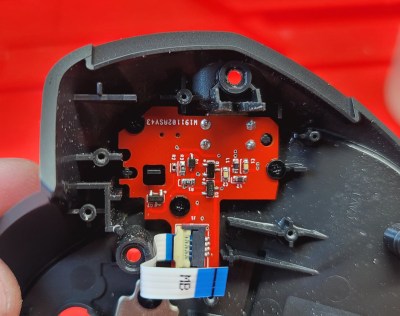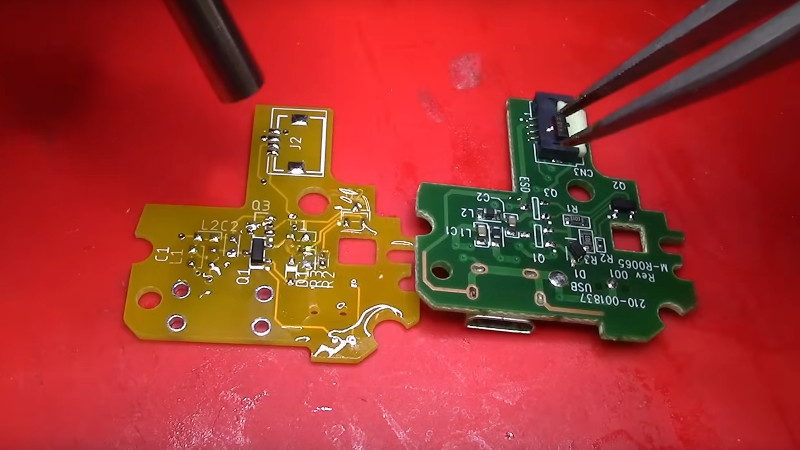As the world of electronic gadgetry made the switch from micro USB to USB-C as the charging port of choice, many of us kept both of the required cables handy. But it’s fair to say that these days a micro USB port has become a pretty rare sight, and the once ubiquitous cable can be a bit elusive in the event that you encounter an older device that requires it.
[Solderking] has a high-end Logitech cordless mouse with just this problem, and so he replaced its micro USB socket with a USB-C port. That makes the task sound deceptively simple, because in fact he had to reverse engineer one of the device’s PCBs in its entirety, making a new board with the same outline and components, but sporting the new connector.
 Instead of attempting to replicate the complex shape with geometry he started with a scan of the board and had Fusion 360 trace its outline before 3D printing a version of it to check fit in the Logitech case. Then it was a case of tracing the circuit, designing the replacement, and hand transferring the parts from board to board.
Instead of attempting to replicate the complex shape with geometry he started with a scan of the board and had Fusion 360 trace its outline before 3D printing a version of it to check fit in the Logitech case. Then it was a case of tracing the circuit, designing the replacement, and hand transferring the parts from board to board.
The result is a USB-C chargeable mouse, and while all the design files don’t appear to be online, it’s possible to download the Gerbers from a PCBWay page. On top of that there’s a YouTube video of the process which we’ve placed below the break.
This isn’t the first time we’ve seen somebody spin up a new board to add USB-C to an older device — this drop-in replacement for Sony’s DualShock 4 comes to mind. If you’ve got enough free space inside your particular gadget, you might be able to pull of a USB-C conversion with nothing more exotic than a hacked up Adafruit breakout board.

















Its also amazing what you can do with a usb-C breakout board and a whole lot of epoxy ;)
you don’t even need to use that much of epoxy.
Epoxy is great (especially with the gun and mixing nozzle), but for plastic consumer products, I’ve started to prefer over time the 3D printing pen, as it can fill and create 3D ribs instead of oozing everywhere.
The result is ugly, but strong enough for the purpose, and even reversible with a solder iron to slice it.
I’ve been a big fan of hot glue ever since I learned one little trick: It is instantly removable with a tiny amount of isopropyl alcohol.
Sticks well to many surfaces, reasonably strong for many applications, fast to assemble, and completely removable.
It is full of wins.
Yeah I don’t know why you’d waste so much time and resources doing this the “legit” way, it’s not like it’s going to be mass-produced. Just glue in a new jack and hand-wire it?
As with all youtube projects, the purpose is not the project but the content
There are a few people inquiring to buy from op on Reddit. I’d imagine most of them lack the ability to solder so a PCB is easier than a breakout and soldering wires
Agree 101%. Although, there is quite a cool (potential) service in the emerging post industrial society:
Instead of spending extra funds on increasingly more luxurious items and status symbols, people making the conscious choice to instead spend on local/custom/repair/reuse options.
So there we could have a nice niche where a side hustle or self funding hobby will both give new life to gadgets, custom belongings and also a more intimate ownership since more people will read about and disassemble their stuff.
So that might look like a subculture where you could buy for example this PCB, and the series would be 10-100pcs.. and probably a social but as well where customers interest and ideas will drive and develop the selection and variety.
It’s kind of a thing already, but not that established and a bit undefined.
Social bit*, darn autocorrect.
And this subculture pattern is/will also be available for most hand made things; you can buy a mitten, or a custom hand made one for 2-3x the cost.
Probably not a “sensible” or economical choice by either party, but if one likes knitting and the other unicorns then.. perfect match.
I had a few premium and expensive logitech mouses . Each of them failed short after a warranty period. I have bought a jaguar from natec for half the price and it works 4th year now with no problem.
Couldn’t you take the USB-C board from the mx3 and retrofit it on the mx or mx2?
Like others, I can’t see myself going to these lengths just to install a different charging socket. But I do find this useful, for the simple reason that it somehow never occurred to me a USB-C socket will physically fit into the space occupied by many micro-B sockets.
I could totally see myself doing it, USB-C is just so much better.
I just ruined my transceiver last night trying to convert my MX Anywhere mouse dongle to USB C, with the video with the green Sugru dongle.
In the end I’m just going to go buy a Bluetooth mouse. I would use words here to describe Logitech’s design team that would be curses in languages that don’t even exist anymore, but that would be useless. Logitech- it’s not 1998 anymore. Get off your ____ and make products using USB C already! It’s 2024! USB C has been relatively common for over 10 years already!
The comment section looks like a joke. Most people ranting about why not use epoxy and some breakout board. The process may just be fun, designing a retrofitting pcb , that fits in and doesn’t look like junk, slapped together with glue by a 4 year old. If this is your way of doing it, go for it but appreciate the work and cleanness someone puts into something like this.
I just bought a micro to c adapter to leave in my mouse. The mouse is that bulky that it’s not noticable.
This looks more like a trackball, than a mouse